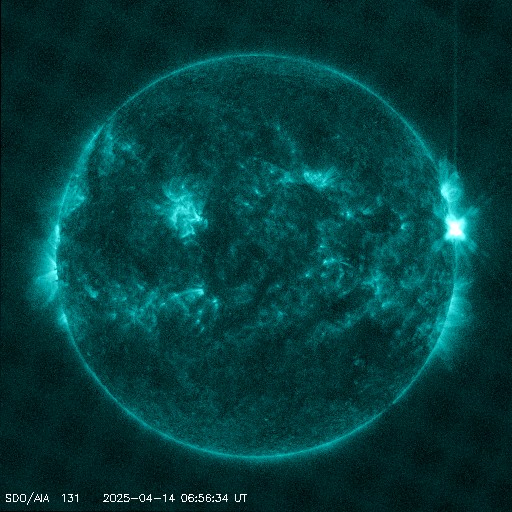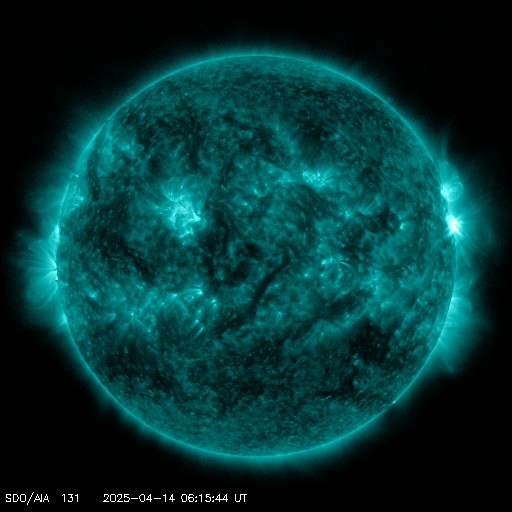Viewing archive of Sunday, 15 April 2001
Solar activity report
Any mentioned solar flare in this report has a scaling factor applied by the Space Weather Prediction Center (SWPC). Because of the SWPC scaling factor, solar flares are reported as 42% smaller than for the science quality data. The scaling factor has been removed from our archived solar flare data to reflect the true physical units.
Report of Solar-Geophysical Activity 2001 Apr 15 2200 UTCPrepared by the NOAA © SWPC and processed by SpaceWeatherLive.com
Joint USAF/NOAA Report of Solar and Geophysical Activity
SDF Number 105 Issued at 2200Z on 15 Apr 2001IA. Analysis of Solar Active Regions and Activity from 14-2100Z to 15-2100Z
Solar activity was high. Region 9415 (S12W87) produced
an X14/2b flare at 15/1350 UTC. This event had an associated Type
II, with a speed of 1000 km/s, and Type IV radio sweeps. It was
also accompanied by a tenflare of 48000 sfu. A 12 degree filament
located at S23W02 disappeared between 14/2054 UTC and 15/1135 UTC.
IB. Solar Activity Forecast
Solar activity is expected to be low
to moderate. Region 9415 is still capable of producing a major
flare before it rotates over the western limb.
IIA. Geophysical Activity Summary 14-2100Z to 15-2100Z
The geomagnetic field was unsettled to active. The X-class event
described in Part IA produced proton events at greater than 10 and
100 MeV flux at geosynchronous orbit which are still in progress.
The greater than 100 MeV crossed event threshold at 15/1405 UTC, and
so far have reached a peak flux of 146 pfu at 15/1525 UTC. The
greater than 10 MeV crossed event threshold at 15/1410 UTC and has
reached a peak flux of 951 pfu at 15/1920 UTC. A ground level event
was measured on the Thule riometer at 15/1505 UTC, and a polar cap
absorption (PCA) event began at 15/1950 UTC.
IIB. Geophysical Activity Forecast
The geomagnetic field is
expected to be quiet to active for April 16 and 17. Active to minor
storm conditions are expected on April 18 as a result of the X14
mentioned in Part IA above. Effects from a high speed coronal
stream may also be expected on April 18. The greater than 10 MeV
proton event is expected to continue for most of the period, and the
greater than 100 MeV proton event is expected to go below threshold
by sometime on April 16.
III. Event Probabilities 16 Apr to 18 Apr
| Class M | 80% | 70% | 60% |
| Class X | 25% | 10% | 10% |
| Proton | 90% | 10% | 10% |
| PCAF | in progress | ||
IV. Penticton 10.7 cm Flux
Observed 15 Apr 134 Predicted 16 Apr-18 Apr 145/150/160 90 Day Mean 15 Apr 166
V. Geomagnetic A Indices
Observed Afr/Ap 14 Apr 013/015 Estimated Afr/Ap 15 Apr 015/015 Predicted Afr/Ap 16 Apr-18 Apr 015/015-015/020-020/035
VI. Geomagnetic Activity Probabilities 16 Apr to 18 Apr
| A. Middle Latitudes | |||
|---|---|---|---|
| Active | 25% | 25% | 50% |
| Minor storm | 05% | 05% | 10% |
| Major-severe storm | 01% | 01% | 05% |
| B. High Latitudes | |||
|---|---|---|---|
| Active | 30% | 35% | 60% |
| Minor storm | 10% | 10% | 15% |
| Major-severe storm | 05% | 05% | 10% |
All times in UTC
Current data suggests there is a slight possibility for aurora to appear at the following high latitude regions in the near future
Gillam, MBLatest news
Latest forum messages
2025/04/12-13 Filament CMEs 2025/04/16 G2 Watch 45Incoming & Unnumbered Active Regions 1708Filaments and prominences 61AR 4055 99Unspecified geomagnetic activity 2258
More topicsSupport SpaceWeatherLive.com!
A lot of people come to SpaceWeatherLive to follow the Sun's activity or if there is aurora to be seen, but with more traffic comes higher server costs. Consider a donation if you enjoy SpaceWeatherLive so we can keep the website online!

Latest alerts
Monday, 14 April 2025
23:15 UTC - Geomagnetic activity
Active geomagnetic conditions (Kp4) Threshold Reached: 23:01 UTC
07:09 UTC - Solar flare
Moderate M4.28 flare from sunspot region 4055
06:48 UTC - Radio Blackout
Minor R1 radio blackout in progress (≥M1 - current: M1.53)
06:24 UTC - Solar flare
Moderate M1.49 flare from sunspot region 4055
06:06 UTC - Radio Blackout
Minor R1 radio blackout in progress (≥M1 - current: M1.16)
Space weather facts
| Last X-flare | 2025/03/28 | X1.1 |
| Last M-flare | 2025/04/14 | M4.2 |
| Last geomagnetic storm | 2025/04/06 | Kp5 (G1) |
| Spotless days | |
|---|---|
| Last spotless day | 2022/06/08 |
| Monthly mean Sunspot Number | |
|---|---|
| March 2025 | 134.2 -20.4 |
| April 2025 | 132.1 -2.1 |
| Last 30 days | 130.6 -13.6 |





